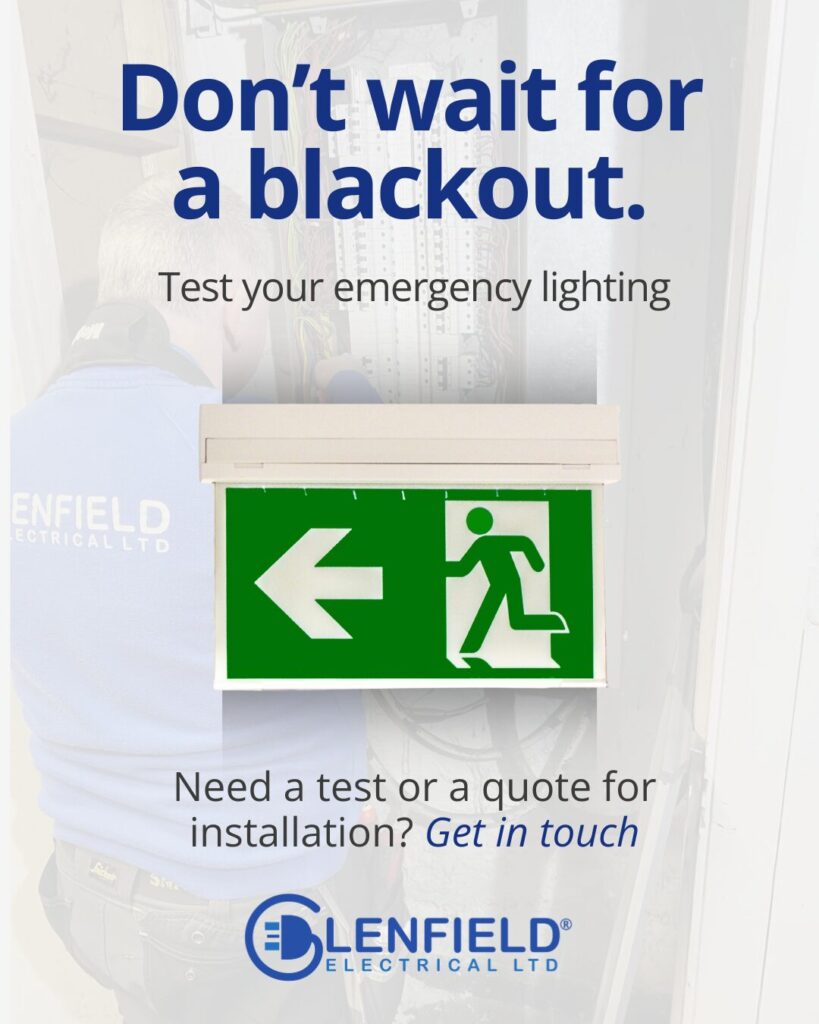
Emergency lighting is one of those things you don’t notice until you really need it. In the event of a power cut or fire, these lights guide people to safety and help avoid panic. That’s why having them in place, and making sure they work, isn’t just good practice – it’s a legal requirement for UK businesses.
This guide explains the key elements of emergency lighting, what testing involves, and how businesses can meet their legal responsibilities.
Understanding the legal side
In the UK, emergency lighting must meet the standards set by BS 5266, which covers how systems are designed, installed and maintained. These rules apply to a wide range of buildings, from offices and schools to hospitals and public venues.
The responsibility for emergency lighting usually falls on the employer or building manager. Someone must be clearly identified as accountable for carrying out checks and ensuring compliance with all relevant safety obligations. Under the Regulatory Reform (Fire Safety) Order 2005, which came into effect in October 2006, the designated ‘responsible person’ is also required to ensure that all staff receive appropriate fire safety training.
Where is emergency lighting needed?
Emergency lighting should be installed in any area where people may need help finding their way out. Key spots include:
- Corridors, staircases and hallways
- Areas with changes in floor level, such as ramps and steps
- Fire safety stations including alarms, extinguishers and blankets
- Internal and external exit doors
- Toilets, especially accessible ones or those with limited natural light
- Lifts and escalators
- Any area where dangerous work or machinery is in use
The lighting must be bright enough for people to see and reach key safety equipment, as well as to exit the building calmly.
Choosing the right Emergency Lighting setup
Not every building requires the same emergency lighting setup. The system you choose should suit your premises and the way people use the space. Consider:
- Building layout and size: Large, open spaces may need brighter or more widespread coverage
- Ceiling height: Taller ceilings can mean stronger lights
- Outdoor needs: External exits need weather-resistant emergency lights
- Evacuation time: If people cannot leave the building immediately (e.g. in hotels), lights must last longer
Choosing a system that fits your space helps ensure it works effectively when needed.
Types of emergency lighting
There are two main types of emergency lighting systems used in commercial buildings:
- Maintained lights: These stay on at all times, just like regular lights, but are connected to a backup power source so they continue to operate during a power cut
-
Non-maintained lights: These remain off during normal conditions and automatically switch on only when the main power fails. They’re typically used in workplaces or areas not in constant use, helping to preserve energy
How to test emergency lighting
Regular testing makes sure your emergency lighting will work when it matters. There are two types of checks to carry out:
Monthly functional tests:
- Use a key switch (also known as a “fish key”) to simulate a power cut
- Check each light turns on and is working properly
- Check for flickering or dim lights
- Log any faults so that they can be fixed
Annual full duration test:
- Run all emergency lights for their full rated time (usually 3 hours)
- If any light fails before the end of the test, it should be repaired or replaced
- This test is often carried out by a qualified professional to ensure accuracy
Keeping good records
After every test, it’s important to log:
- The date of the test
- Which lights were tested
- Any faults or issues found
- Repairs or maintenance actions taken
Each light should be labelled so it’s easy to track. Keeping clear records can also help during inspections.
Common issues to watch for
Even with regular checks, faults can happen. Here are a few things to look out for:
- Batteries not charging properly
- Lights that flicker or seem dim
- Signs of moisture or heat damage
- Lights that have been moved, covered or blocked
Who is responsible for ensuring emergency lighting systems are maintained?
The business owner or designated “responsible person” must ensure emergency lights are tested and maintained. Monthly checks can be done in-house if staff are trained, but the full annual test should usually be carried out by a competent person – in this case experienced electricians. Everyone involved in safety procedures should be clear on who is responsible for testing, logging and fixing issues.
How to stay compliant
To keep your business safe and compliant:
- Schedule monthly and annual testing
- Assign clear responsibility
- Keep a written log
- Act quickly on any faults
- Include emergency lighting in your wider fire safety review
Why staying on top of testing matters
Emergency lighting might not be the most visible part of your safety plan, but when things go wrong, it plays a vital role. A well-maintained system helps people stay calm, find their way out quickly and avoid dangerous situations in the event of a fire or power failure.
Sticking to a regular testing routine means faults don’t go unnoticed and your paperwork stays in order. More importantly, it shows that safety is something you take seriously, not just in theory but in practice.
Book your emergency lighting service today
Whether you need new emergency lights fitted, or existing ones tested, staying on top of this essential safety measure keeps your building compliant and protects the people inside it.
Our qualified engineers carry out thorough testing and installations to make sure your system is ready when it’s needed most
Contact us today to book your emergency lighting service.
